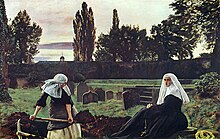Wanita pada Abad Pertengahan

Wanita pada Abad Pertengahan menduduki sejumlah peran sosial berbeda. Pada Abad Pertengahan, periode sejarah Eropa yang berlangsung dari sekitar abad ke-5 sampai ke-15, wanita memegang posisi istri, ibu, petani, artisan dan biarawati, serta beberapa peran kepemimpinan penting, seperti abbess atau wali ratu. Konsep "wanita" berubah dalam sejumlah cara pada Abad Pertengahan[1] dan beberapa unsur mempengaruhi peran wanita pada periode tersebut.
Referensi[sunting | sunting sumber]
- ^ Allen 2006a, hlm. 6.
Sumber[sunting | sunting sumber]
- Allen, Prudence (1997). The Aristotelian Revolution, 750BC - AD1250. The Concept of Woman. Volume 1. Eerdmans. ISBN 978-0802842701.
- Allen, Prudence (2006a). The Early Humanist Reformation, 1250-1500, Part 1. The Concept of Woman. Volume 2. Eerdmans. ISBN 978-0802833464.
- Allen, Prudence (2006b). The Early Humanist Reformation, 1250-1500, Part 2. The Concept of Woman. Volume 2. Eerdmans. ISBN 978-0802833471.
- Bennett, Judith M. (1984). "The Tie That Binds: Peasant Marriages and Families in Late Medieval England". The Journal of Interdisciplinary History. 15 (1): 111–129. doi:10.2307/203596.
- Bouchard, Constance B. (1981). "Consanguinity and Noble Marriages in the Tenth and Eleventh Centuries". Speculum. 56 (2): 268–287. doi:10.2307/2846935. JSTOR 2846935. PMID 11610836.
- Bullough, Vern; Campbell, Cameron (1980). "Female Longevity and Diet in the Middle Ages". Speculum. Cambridge: Medieval Academy of America, Cambridge University Press. 55 (2): 317–325. doi:10.2307/2847291.
- Classen, Albrecht (2007). Old age in the Middle Ages and the Renaissance: interdisciplinary approaches to a neglected topic. Fundamentals of Medieval and Early Modern Culture. Walter de Gruyter. ISBN 978-3110195484.
- Dowty, Alan (1989). Closed Borders: The Contemporary Assault on Freedom of Movement. Twentieth Century Fund Report. Yale University Press. ISBN 978-0300044980.
- Erler, Mary C.; Kowaleski, Maryanne (2003). Gendering the Master Narrative: Women and Power in the Middle Ages. Cornell University Press. ISBN 978-0801488306.
- Franklin, Peter (1986). "Peasant widows' "liberation" and remarriage before the Black Death". The Economic History Review. 39 (2): 186–204. doi:10.2307/2596149. JSTOR 2596149.
- Garay, Kathleen; Jeay, Madeleine (2007). "Advice concerning pregnancy and health in Late Medieval Europe: peasant women's wisdom in The Distaff Gospels". Canadian Bulletin of Medical History/Bulletin canadien d'histoire de la médecine. 24 (1): 423–443. PMID 18447313. Diarsipkan dari versi asli tanggal 2015-09-12. Diakses tanggal 2018-08-14.
- Georgieva, Sashka (2003). "Marital Infidelity in Christian West European and Bulgarian Mediaeval Low (A Comparative Study)". Bulgarian Historical Review. Sofia: Prosveta. 31 (3-4): 113–126.
- Green, Monica H. (2013). "Caring for Gendered Bodies". Dalam Judith Bennett and Ruth Mazo Karras. Oxford Handbook of Women and Gender in Medieval Europe. Oxford: Oxford University Press. ISBN 978-0-19-958217-4.
- Greif, Avner (2011) [2005]. Family Structure, Institutions, and Growth: The Origin and Implications of Western Corporatism (PDF). Stanford University. Diarsipkan dari versi asli (PDF) tanggal 2015-09-04. Diakses tanggal 2018-08-14.
- Hanawalt, B. A. (1998). "Medieval English Women in Rural and Urban Domestic Space". Dumbarton Oaks Papers. 52: 19–26. doi:10.2307/1291776.
- Harding, Alan (1980). "Political Liberty in the Middle Ages". Speculum. Cambridge: Medieval Academy of America, Cambridge University Press. 55 (3): 423–443. doi:10.2307/2847234.
- Heather, Peter J. (1999). The Visigoths from the Migration Period to the Seventh Century: An Ethnographic Perspective. Boydell & Brewer. ISBN 978-0851157627. OCLC 185477995.
- Levin, Eve (1995). Sex and Society in the World of the Orthodox Slavs, 900-1700. Cornell University Press. ISBN 978-0801483042.
- McDougall, Sara (2013). "Women and Gender in Canon Law". Dalam Judith Bennett and Ruth Mazo Karras. Oxford Handbook of Women and Gender in Medieval Europe. Oxford: Oxford University Press. hlm. 163–178. ISBN 978-0-19-958217-4.
- Middleton, Chris (1981). "Peasants, patriarchy and the feudal mode of production in England: 2 Feudal lords and the subordination of peasant women". Sociological Review. 29 (1): 137–154. doi:10.1111/j.1467-954x.1981.tb03026.x.
- Mitterauer, Michael (2010). Why Europe?: The Medieval Origins of Its Special Path. transl. Gerald Chapple. University of Chicago Press. ISBN 978-0226532530.
- de Pizan, Christine (2003). The Treasure of the City of Ladies, or The Book of the Three Virtues. transl. Sarah Lawson. Penguin Classics. ISBN 978-0140449501.
- Rivers, Theodore John (1986). The Laws of Salian and Ripuarian Franks. AMS studies in the Middle Ages. 8. New York: AMS Press. ISBN 978-0404614386.
- Schaus, Margaret C., ed. (2006). Women and gender in medieval Europe: an encyclopedia. CRC Press. ISBN 978-0415969444.
- Shahar, Shulamith (2004). Growing Old in the Middle Ages: 'winter clothes us in shadow and pain'. transl. Yael Lotan. Routledge. ISBN 978-0415333603.
- Thurston, Herbert (1908). "Deaconesses". Dalam Herbermann, Charles. Catholic Encyclopedia. New York: Robert Appleton.
- Vinogradoff, Sir Paul (1892). Villainage in England: Essays in English Medieval History (edisi ke-Reissued 2010). Cambridge University Press. ISBN 978-1108019637.
- Whittle, Jane (2010). "Rural Economy". Dalam Bennett, Judith M.; Mazo Karras, Ruth. Oxford Handbook of Women and Gender in Medieval Europe. ISBN 978-0199582174.
- Reyerson, Kathryn (2010). "Urban Economy". Dalam Bennett, Judith M.; Mazo Karras, Ruth. Oxford Handbook of Women and Gender in Medieval Europe. ISBN 978-0199582174.
- Williams, Marty Newman; Echols, Anne (1994). Between Pit and Pedestal: Women in the Middle Ages. Markus Wiener. ISBN 978-0910129343.
Wikimedia Commons memiliki media mengenai Medieval women.
